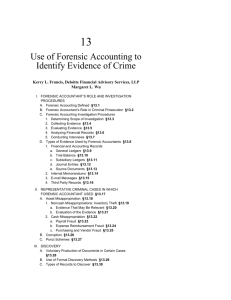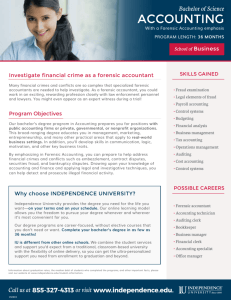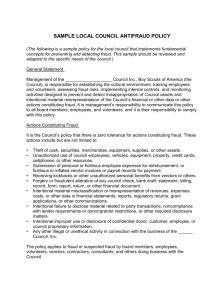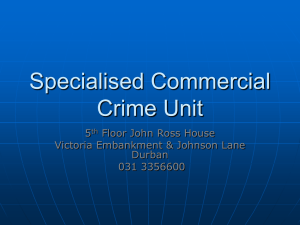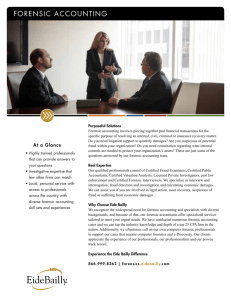FORENSIC AUDITING
advertisement
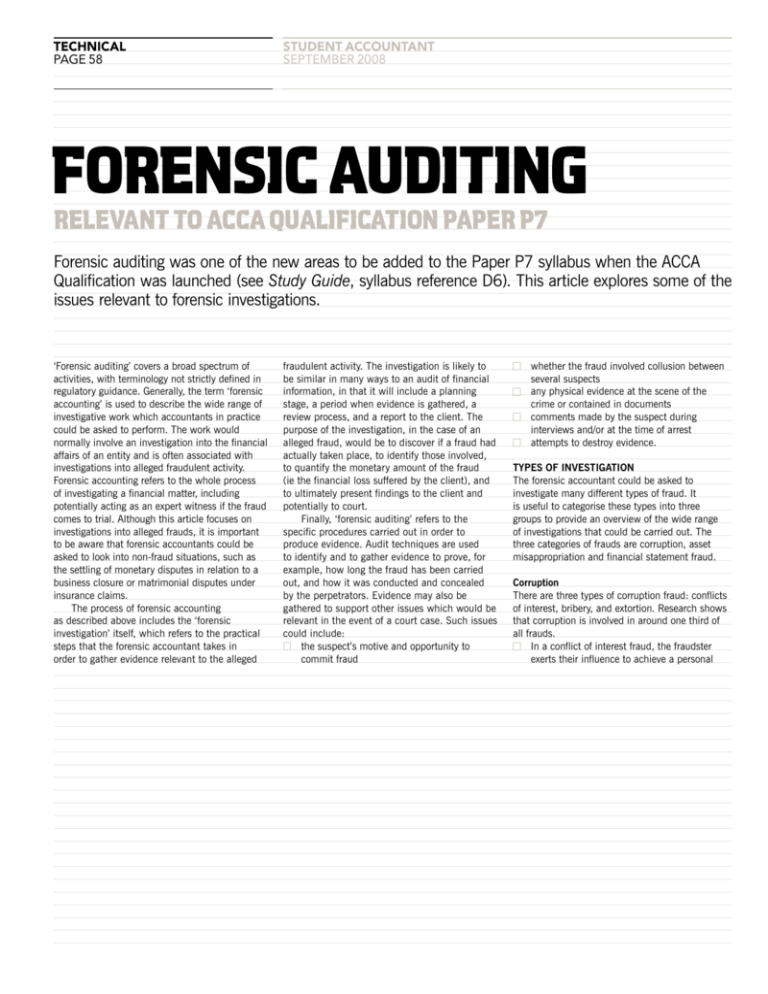
technical page 58 student accountANT SEPTEMBER 2008 FORENSIC AUDITING RELEVANT TO ACCA QUALIFICATION PAPER P7 Forensic auditing was one of the new areas to be added to the Paper P7 syllabus when the ACCA Qualification was launched (see Study Guide, syllabus reference D6). This article explores some of the issues relevant to forensic investigations. ‘Forensic auditing’ covers a broad spectrum of activities, with terminology not strictly defined in regulatory guidance. Generally, the term ‘forensic accounting’ is used to describe the wide range of investigative work which accountants in practice could be asked to perform. The work would normally involve an investigation into the financial affairs of an entity and is often associated with investigations into alleged fraudulent activity. Forensic accounting refers to the whole process of investigating a financial matter, including potentially acting as an expert witness if the fraud comes to trial. Although this article focuses on investigations into alleged frauds, it is important to be aware that forensic accountants could be asked to look into non-fraud situations, such as the settling of monetary disputes in relation to a business closure or matrimonial disputes under insurance claims. The process of forensic accounting as described above includes the ‘forensic investigation’ itself, which refers to the practical steps that the forensic accountant takes in order to gather evidence relevant to the alleged fraudulent activity. The investigation is likely to be similar in many ways to an audit of financial information, in that it will include a planning stage, a period when evidence is gathered, a review process, and a report to the client. The purpose of the investigation, in the case of an alleged fraud, would be to discover if a fraud had actually taken place, to identify those involved, to quantify the monetary amount of the fraud (ie the financial loss suffered by the client), and to ultimately present findings to the client and potentially to court. Finally, ‘forensic auditing’ refers to the specific procedures carried out in order to produce evidence. Audit techniques are used to identify and to gather evidence to prove, for example, how long the fraud has been carried out, and how it was conducted and concealed by the perpetrators. Evidence may also be gathered to support other issues which would be relevant in the event of a court case. Such issues could include: the suspect’s motive and opportunity to commit fraud whether the fraud involved collusion between several suspects any physical evidence at the scene of the crime or contained in documents comments made by the suspect during interviews and/or at the time of arrest attempts to destroy evidence. TYPES OF INVESTIGATION The forensic accountant could be asked to investigate many different types of fraud. It is useful to categorise these types into three groups to provide an overview of the wide range of investigations that could be carried out. The three categories of frauds are corruption, asset misappropriation and financial statement fraud. Corruption There are three types of corruption fraud: conflicts of interest, bribery, and extortion. Research shows that corruption is involved in around one third of all frauds. In a conflict of interest fraud, the fraudster exerts their influence to achieve a personal technical page 59 LINKED PERFORMANCE OBJECTIVES PERFORMANCE OBJECTIVES 17 AND 18 ARE RELEVANT TO PAPER P7 gain which detrimentally affects the company. The fraudster may not benefit financially, but rather receives an undisclosed personal benefit as a result of the situation. For example, a manager may approve the expenses of an employee who is also a personal friend in order to maintain that friendship, even if the expenses are inaccurate. Bribery is when money (or something else of value) is offered in order to influence a situation. Extortion is the opposite of bribery, and happens when money is demanded (rather than offered) in order to secure a particular outcome. Asset misappropriation By far the most common frauds are those involving asset misappropriation, and there are many different types of fraud which fall into this category. The common feature is the theft of cash or other assets from the company, for example: Cash theft – the stealing of physical cash, for example petty cash, from the premises of a company. Fraudulent disbursements – company funds being used to make fraudulent payments. Common examples include billing schemes, where payments are made to a fictitious supplier, and payroll schemes, where payments are made to fictitious employees (often known as ‘ghost employees’). Inventory frauds – the theft of inventory from the company. Misuse of assets – employees using company assets for their own personal interest. Financial statement fraud This is also known as fraudulent financial reporting, and is a type of fraud that causes a material misstatement in the financial statements. It can include deliberate falsification of accounting records; omission of transactions, balances or disclosures from the financial statements; or the misapplication of financial reporting standards. This is often carried out with the intention of presenting the financial statements with a particular bias, for example concealing liabilities in order to improve any analysis of liquidity and gearing. CONDUCTING AN INVESTIGATION The process of conducting a forensic investigation is, in many ways, similar to the process of conducting an audit, but with some additional considerations. The various stages are briefly described below. Accepting the investigation The forensic accountant must initially consider whether their firm has the necessary skills and experience to accept the work. Forensic investigations are specialist in nature, and the work requires detailed knowledge of fraud investigation techniques and the legal framework. Investigators must also have received training in interview and interrogation techniques, and in how to maintain the safe custody of evidence gathered. Additional considerations include whether or not the investigation is being requested by an audit client. If it is, this poses extra ethical questions, as the investigating firm would be potentially exposed to self-review, advocacy and management threats to objectivity. Unless robust safeguards are put in place, the firm should not provide audit and forensic investigation services to the same client. Commercial considerations are also important, and a high fee level should be negotiated to compensate for the specialist nature of the work, and the likely involvement of senior and experienced members of the firm in the investigation. Planning the investigation The investigating team must carefully consider what they have been asked to achieve and plan their work accordingly. The objectives of the investigation will include: identifying the type of fraud that has been operating, how long it has been operating for, and how the fraud has been concealed identifying the fraudster(s) involved quantifying the financial loss suffered by the client gathering evidence to be used in court proceedings providing advice to prevent the reoccurrence of the fraud. The investigators should also consider the best way to gather evidence – the use of computer assisted audit techniques, for example, is very common in fraud investigations. Gathering evidence In order to gather detailed evidence, the investigator must understand the specific type of fraud that has been carried out, and how the fraud has been committed. The evidence should be sufficient to ultimately prove the identity of the fraudster(s), the mechanics of the fraud scheme, technical page 60 student accountANT SEPTEMBER 2008 and the amount of financial loss suffered. It is important that the investigating team is skilled in collecting evidence that can be used in a court case, and in keeping a clear chain of custody until the evidence is presented in court. If any evidence is inconclusive or there are gaps in the chain of custody, then the evidence may be challenged in court, or even become inadmissible. Investigators must be alert to documents being falsified, damaged or destroyed by the suspect(s). Evidence can be gathered using various techniques, such as: testing controls to gather evidence which identifies the weaknesses, which allowed the fraud to be perpetrated using analytical procedures to compare trends over time or to provide comparatives between different segments of the business applying computer assisted audit techniques, for example to identify the timing and location of relevant details being altered in the computer system discussions and interviews with employees substantive techniques such as reconciliations, cash counts and reviews of documentation. did actually occur. For this reason, the investigators are likely to avoid deliberately confronting the alleged fraudster(s) until they have gathered sufficient evidence to extract a confession. The interview with the suspect is a crucial part of evidence gathered during the investigation. imperative that the members of the investigative team called to court can present their evidence clearly and professionally, as they may have to simplify complex accounting issues so that non-accountants involved in the court case can understand the evidence and its implications. Reporting The client will expect a report containing the findings of the investigation, including a summary of evidence and a conclusion as to the amount of loss suffered as a result of the fraud. The report will also discuss how the fraudster set up the fraud scheme, and which controls, if any, were circumvented. It is also likely that the investigative team will recommend improvements to controls within the organisation to prevent any similar frauds occurring in the future. CONCLUSION In summary, a forensic investigation is a very specialist type of engagement, which requires highly skilled team members who have experience not only of accounting and auditing techniques, but also of the relevant legal framework. There are numerous different types of fraud that a forensic accountant could be asked to investigate. The investigation is likely to ultimately lead to legal proceedings against one or several suspects, and members of the investigative team must be comfortable with appearing in court to explain how the investigation was conducted, and how the evidence has been gathered. Forensic accountants must therefore receive specialist training in such matters to ensure that their credibility and professionalism cannot be undermined during the legal process. The ultimate goal of the forensic investigation team is to obtain a confession by the fraudster, if a fraud Court proceedings The investigation is likely to lead to legal proceedings against the suspect, and members of the investigative team will probably be involved in any resultant court case. The evidence gathered during the investigation will be presented at court, and team members may be called to court to describe the evidence they have gathered and to explain how the suspect was identified. It is Lisa Weaver is examiner for Paper P7

